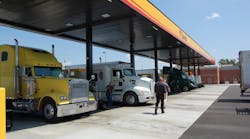Average retail pump prices in the U.S. for both diesel and gasoline dropped this week, according to data tracked by the Energy Information Administration (EIA), though prices remain elevated compared to those posted during the same week last year.
Diesel declined 2.6 cents to $3.892 per gallon this week, the agency said, which is 4.3 cents per gallon higher compared to the same time period in 2013.
All regions of the country reported declines in diesel prices this week, with prices declining the most in the Central Atlantic – dropping 3.7 cents to $4.079 per gallon – followed by a 3.2 cent decline to $4.092 per gallon in New England. California joined both regions as the only areas within the U.S. where diesel exceeded the $4 per gallon mark – in California’s case, declining to $4.074 per gallon this week.
Gasoline declined by a national average of 1.6 cents to $3.674 per gallons this week, EIA reported, which is 1.9 cents higher per gallon compared to the same week in 2013.
Prices for gasoline dropped in all regions of the country except for two. The Rocky Mountain region witnessed an increase – up 3/10ths of a penny to $3.507 per gallon – as did the West Coast, though with California’s pricing removed; an area were prices inched up 5/10ths of a penny to $3.804 per gallon.
The biggest one-week declines in gasoline occurred in the Lower Atlantic – a 2.4 cent drop to $3.556 per gallon – and in the Gulf Coast area, where prices fell 2.2 cents to $3.418 per gallon.
The EIA also noted this week that as domestic crude oil production in the U.S. increased over the past few years, producers continue to increasingly move such “onshore” crude oil out of production areas via railroad transport.
Producers in North Dakota, in particular, are using rail to ship crude oil to refineries and midstream companies at newly-built unloading terminals on the East Coast and West Coast, the agency said.
The number of rail carloads of crude oil began rising in 2012, according to EIA data, with Bakken rail outflow capacity totalling 965,000 barrels per day (bbl/d) at the end of 2013, compared to 515,000 bbl/d of pipeline capacity.
While some refineries are being built or planned for the area, most Bakken crude oil will continue to be moved out of the region to be processed at refineries in other parts of the country.
In addition to crude-by-rail loading facilities in the Bakken, the agency said new rail terminals have been built to transport crude oil production from the Niobrara Shale formation in Colorado and Wyoming, and the Permian Basin in West Texas and southeastern New Mexico.
Several crude-by-rail loading terminals are already operating in the Niobrara, which has access to a vast rail network to transport abundant coal production from Wyoming's Powder River Basin. While the Permian Basin has much greater oil production than the Niobrara Shale, it also relies more on pipelines to transport crude oil production.
However, in response to significant production growth there, particularly from tight oil formations, Rangeland Energy last month began construction on its RIO Hub rail loading terminal in Loving, New Mexico. This terminal is scheduled to begin operating later this year, with the project's developers expecting to eventually raise its capacity to 100,000 bbl/d.



